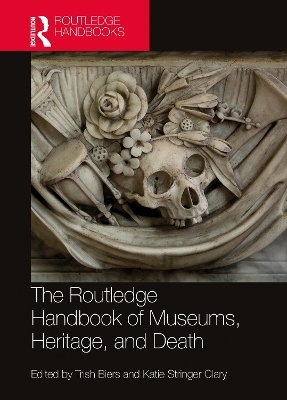
The Routledge Handbook of Museums, Heritage, and Death
Routledge (Verlag)
978-1-032-04704-1 (ISBN)
This book provides a comprehensive examination of death, dying, and human remains in museums and heritage sites around the world.
Presenting a diverse range of contributions from scholars, practitioners, and artists, the book reminds us that death and the dead body are omnipresent in museum and heritage spaces. Chapters appraise collection practices and their historical context, present global perspectives and potential resolutions, and suggest how death and dying should be presented to the public. Acknowledging that professionals in the galleries, libraries, archives, and museums (GLAM) fields are engaging in vital discussions about repatriation and anti-colonialist narratives, the book includes reflections on a variety of deathscapes that are at the forefront of the debate. Taking a multivocal approach, the handbook provides a foundation for debate as well as a reference for how the dead are treated within the public arena. Most important, perhaps, the book highlights best practices and calls for more ethical frameworks and strategies for collaboration, particularly with descendant communities.
The Routledge Handbook of Museums, Heritage, and Death will be useful to all individuals working with, studying, and interested in curation and exhibition at museums and heritage sites around the world. It will be of particular interest to those working in the fields of heritage, museum studies, death studies, archaeology, anthropology, sociology, and history.
Trish Biers curates the Duckworth Laboratory (human and non-human primate remains) in the Centre for Human Evolutionary Studies in the Department of Archaeology at the University of Cambridge. Katie Stringer Clary is an Assistant Professor of Interdisciplinary Studies at Coastal Carolina University.
Introduction. Part 1: Acquisition, Curation, and Conservation of the Dead. 1. Historical Contexts of Bodies, Display, and Spectacle. 2. Conserving the Humanity of Human Remains. 3. A Museum Archive: An Unexpected Final Resting Place but One Full of Promise. 4. Striking a Balance: Preserving, Curating, and Investigating Human Remains from the Capuchin Catacombs of Palermo, Sicily. 5. The Handling of the Remains of the Ancestors in Peru: Realities, Challenges, and Wishes. 6. Engaging with Death in Museums and Collections. Part 2: Displaying the Dead: Exhibitions and Ethical Considerations. 7. Education, Preservation and Reconciliation: The J.L. Shellshear Museum and the Preservation and Display of Human Remains. 8. The Mummies of Guanajuato: The Tension between Ethics and Ambition. 9. The Cost of Civil Rights: Loss, Grief, and Death at US Civil Rights Museums. 10. Changing People, Changing Content: New Perspectives on Past Peoples. 11. Transforming Memento Mori: A Contemporary Lens. 12. The Hollywood Museum of Death: The Commodification of the Maiden, Criminal and the Corpse. Part 3: Decolonisation and Shifting the Perspective in Museums and Heritage. 13. Papuan Pasts: The Origins of Papuan Human Remains Collections in the World’s Museums, the Issue of Repatriation, and Telling New Stories with Skeletal Data. 14. Searching for Identities through Archaeological Human Remains in Turkey. 15. Entangled Entitlements and Shuar Tsantsa (Shrunken Heads). 16. Julia Pastrana’s Long Journey Home. 17. Egyptian Mummified Remains: Communities of Descent and Practice. 18. The Curated Ossilegium: Museum Practices as Death and Mourning Rituals. Part 4: Deathscapes and Heritage. 19. From Dead Places to Places of the Dead: The Memorial Power of Battlefields, Ruins, and Burials in the Warscapes of Spain and the Western Front. 20. From Trauma to Tourism: Balancing the Needs of the Living and the Dead. 21. Death, Memory, and Power: Public Memorial Culture of Moscow Necropolises. 22. Not Their Heritage Theme Park: Honouring the Outcast at Crossbones Graveyard. 23. The Ghosts of Kūkai: Virtual Heritage and Landscapes of Death in Japan’s Shikoku Pilgrimage. 24. A Shadow Pandemic: Protest, Mourning, and Grassroots Memorialization in Mexico City. Part 5: Public Education and Engagement in Museums and Heritage. 25. Engagement That Works: Practical Insights for Inviting the Public into Cemeteries. 26. Talking About the D Word: Public Engagement in a Place of the Dead. 27. The Death Positive Library. 28. Haunted Houses and Horrific History: Ghost Tours at Historic House Museums. 29. Walking, Public Engagement, and Pedagogy: Mobile Death Studies. Part 6: Death Studies and Heritage in Practice. 30. The Cemetery Church of All Saints with the Ossuary. 31. Memento Mori Exhibition from the Dominican Crypt, Vác (Március 15 Square, 19) Hungary. 32. Our Queerly Departed – Researching, Remembering and Respecting the LGBTQ+ Deceased. 33. Close Encounters with Death and Disease: Young Visitors’ Perspectives at the Mütter Medical History Museum. 34. The Use of CT scan for the Construction of Mummy Replicas for Museography: Social and Ethical Perspectives. Part 7: Concluding Remarks.
| Erscheinungsdatum | 28.07.2023 |
|---|---|
| Reihe/Serie | Routledge Handbooks on Museums, Galleries and Heritage |
| Zusatzinfo | 5 Tables, black and white; 59 Halftones, black and white; 59 Illustrations, black and white |
| Verlagsort | London |
| Sprache | englisch |
| Maße | 156 x 234 mm |
| Gewicht | 1080 g |
| Themenwelt | Kunst / Musik / Theater |
| Sachbuch/Ratgeber ► Gesundheit / Leben / Psychologie | |
| Reisen ► Reiseführer | |
| Geisteswissenschaften ► Geschichte ► Hilfswissenschaften | |
| Studium ► Querschnittsbereiche ► Prävention / Gesundheitsförderung | |
| Sozialwissenschaften ► Soziologie ► Mikrosoziologie | |
| ISBN-10 | 1-032-04704-6 / 1032047046 |
| ISBN-13 | 978-1-032-04704-1 / 9781032047041 |
| Zustand | Neuware |
| Informationen gemäß Produktsicherheitsverordnung (GPSR) | |
| Haben Sie eine Frage zum Produkt? |
aus dem Bereich


